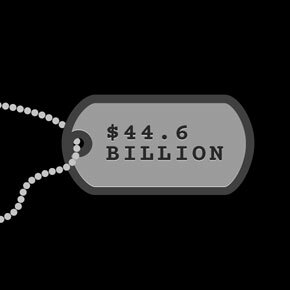
$44.6 Billion: The unseen cost of US war dead
May 27th, 2013Many analysts have criticized US aggression in Iraq and Afghanistan by comparing them to Vietnam. As the saying goes, even if the US won every battle, they lost the war. It’s a little different than Vietnam in that the US was not ultimately forced to withdraw, but US still lost the war if you measure by the freedom left at home, or the price tag. Considered together, Iraq and Afghanistan will be the most expensive war in US history.
Linda J. Bilmes of the Harvard Kennedy School has estimated the total cost of these conflicts somewhere between $4 and $6 trillion dollars. Of course the wars are funded almost completely through borrowing, not direct taxation. More than $1.3 trillion of that bill has been added to the national debt. But these are numbers that can be audited. They can be calculated objectively so long as accurate numbers can be discovered. The more abstract cost of war is the more than six thousands dead soldiers, and another six thousand dead contractors.
The unseen cost of war is the opportunity cost of every single act of economic or social value that would have been performed by the war dead if they had instead pursued productive work. From where I sit this is a figure that is almost impossible to estimate, but Linda J. Bilmes puts it at $44.6 billion. She calculated this using a figures from various government agencies’ estimates of the “value of a statistical life” (VSL). In other words, assuming that the 12,000 dead lead statistically average lives, how much economic productivity is lost? She estimates the VSL of an American life as a little over $7 million, although she admits this is a low estimate because it doesn’t account for costs to family members who’s lives are disheveled.
Now, to me there’s something just a little icky about reducing human lives to a dollar value, but there’s something even more nasty about only calculating one side of the conflict. It begs the question, what the VSL of lived lost in Iraq and Afghanistan, and what’s the economic impact of their war dead?
These numbers are harder to find. It doesn’t seem like anyone cares enough to calculate them. The difficulty is exacerbated by the fact that the $7 million figure isn’t based on people’s earning potential, or their contributions to society, or how much they are loved by friends and family. Instead, government agencies calculate the VSL based on what people are willing to pay to avoid taking risks, and on how much employers pay their workers to take additional risks. Most of the data is drawn from payroll statistics, which we don’t have of Iraq and Afghanistan.
We can still do a little back of the envelope calculation, at least for Iraq. It won’t be the same calculation, but it will be something.
According to Iraq-Business News that average income in Iraq in 2012 was $6,000. Now, that’s going to produce a low estimate, because the average income would have been higher before the US completely devastated their country, but I couldn’t those numbers. According to IraqBodyCount.org the estimated civilian deaths in Iraq is between 112,789 and 123,419. So taking a middle figure let’s use 118,104. Assuming 40 years of productive work, that’s $2.8 billion in a $115.4 billion GDP.
Find out where you can see Silver Circle by checking our theater and special screening schedule on -->our event page -->.


